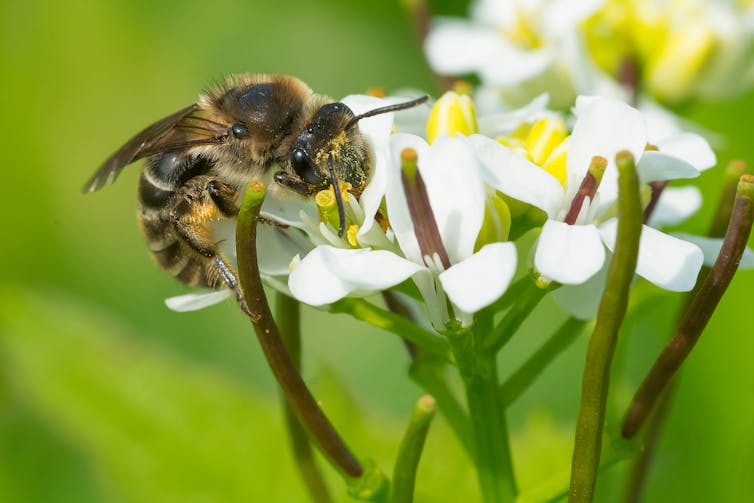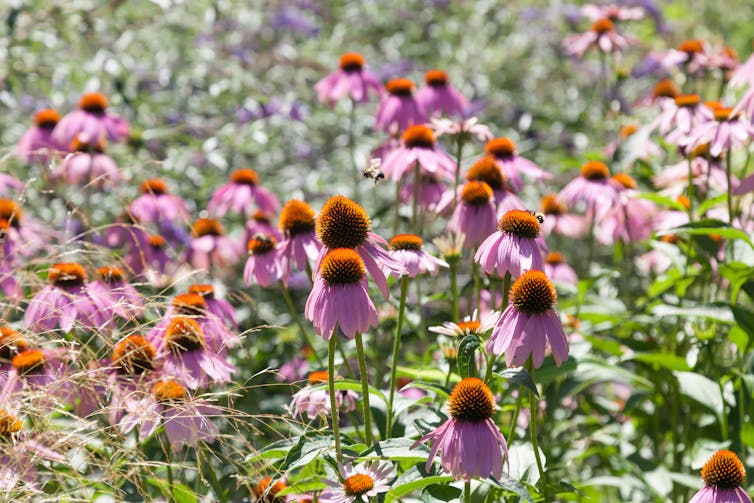Canada is home to more than 800 species of wild bees — few may have noticed the diversity of native bees buzzing around, but bees play a significant role in the survival of native plant populations.
With changes in climate, habitat loss, pesticide use and pathogen spillover, some of our native bees are in decline.
Our research takes place along a section of the Niagara Escarpment, which features a huge diversity of native plants, many microclimates, and lots of natural land that makes ideal habitats for wild bees.
The vast majority of wild bee species are rare. More than 200 species live in the habitat-rich forests, fields and neighbourhoods around Hamilton and McMaster University, where they are the subjects of our research.

In Ontario, there are many different types of bees, including bumblebees, carder bees, carpenter bees, cellophane bees, cuckoo bees, leaf cutter bees, long horned bees, mason bees, mining bees, sweat bees and yellow-faced bees.
Read more: Most bees don't die after stinging – and other surprising bee facts
Many of our wild bees are solitary, highly specialized and transient from one year to the next. This makes them hard to track, especially when some species are only active for a period of weeks each year. These already-small populations are especially susceptible to competition and disease from domesticated bees.
Impacts on wild bees
Domestic honeybees can have negative effects on wild bee populations, both through direct competition and by indirectly affecting the reproductive success of some native and commercial plants that count on specialized wild bees to pollinate them. Blueberry bushes, which are native to eastern North America produce better and greater yields in the presence of native bees that practice buzz pollination.
There has been a huge proliferation in beekeeping as a hobby, driven by well-meaning citizens who have started hives on rooftops and in backyards and community gardens, believing they are helping the environment.
More domesticated bees are also being used in agriculture now, with some pollinators-for-hire services driving hives to huge farms to service blossoming crops. Those bees also roam and forage for many kilometres beyond the targeted fields, which is a concern near conservation areas.
While other bees are still hungry and groggy from the winter, well-fed domestic honeybees are already in top shape, appearing in large numbers to feed at vital early-spring sources, including plants with short bloom cycles such as spring beauty, trout lily and trees such as maples and willows.
A lesser-known consequence of imported bees is the risk of pathogen spillovers, when diseases or parasites move from their original hosts to new species. The rusty-patch bumblebee, for example, was common in Ontario until the 1990s, but is now officially considered endangered. This is likely due to pathogen spillover from domestic bumblebees used to pollinate greenhouse crops.

Bee versus bee
Honeybees are omnipresent, persistent generalists that forage through the entire blooming season, compared to roughly 15 per cent of our native bees which are pollen specialists, restricted to specific native plants to provide the pollen used to feed their young. The presence of large numbers of honeybees may disrupt these ecological links and result in changes to plant-pollinator relationships.
One colony of 10,000 honeybees may collect 10 kilograms of pollen over a three-month period, an amount that would support 100,000 solitary wild bees.
To most of its competitors, the honeybee is also a giant. A honeybee is about 1.2 cm long and can fly for kilometres, while a typical native bee might be eight millimetres long, with a maximum flight distance of only 300 metres.
Honeybees bully some wild bees and other pollinating insects such as wasps, flies and beetles out of the blossoms they need to survive. They even force burly bumblebees out of flowers.
Inconspicuous vulnerability
Wild bees persist in in-between pockets of land, where their mainly solitary living quarters are inconspicuous and vulnerable to destruction. Borders between farmers’ fields, for example, are critical to wild bees, which nest primarily on or in the ground among dried leaves, stalks and sticks. One species, the eastern snail shell mason bee, even nests in the shells of dead snails.
In cities, residential neighbourhoods are critical to wild bees, which live in uncultivated pockets at the backs of flower beds, under hedges and in open lots. These areas provide bees with key corridors between more expansive natural spaces, and are essential to their survival.
There is still a lot to learn of the wild bees in North America, and we hope our research will be helpful. What we have learned so far confirms that while some wild bees can take advantage of new resources to expand their populations, many others face negative consequences from climate change and invasive species.

Supporting bees
Outreach efforts, such as the publication of the Bees of Toronto guide by the City of Toronto, provide fascinating insights into the diversity of Ontario bees, fostering a deeper appreciation.
A growing number of local nurseries now provide a range of native plants that are better suited to attract bees and other wildlife. Local efforts such as the Hamilton Pollinator Paradise Project promote native gardens to provide corridors for bees and other pollinators such as butterflies.
McMaster University is a bee-certified campus, and the City of Hamilton is a bee-certified city through Pollinator Partnership Canada.
Such efforts are key to the long-term maintenance and resilience of our native bees. Initiatives by local groups bring together science and local interest in gardening to provide helpful advice on creating beautiful, and ecologically functional gardens.
This spring and summer, you may want to keep a sympathetic eye out for wild bees. If we make a little space for them, they will more than repay the favour.

